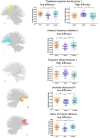Strategic white matter injury associated with long-term information processing speed deficits in mild traumatic brain injury
- PMID: 32657510
- PMCID: PMC7502829
- DOI: 10.1002/hbm.25135
Strategic white matter injury associated with long-term information processing speed deficits in mild traumatic brain injury
Abstract
Deficits in information processing speed (IPS) are among the earliest and most prominent cognitive manifestations in mild traumatic brain injury (mTBI). We investigated the impact of white matter fiber location on IPS outcome in an individual basis assessment. A total of 112 acute mild TBI with all CT negative underwent brain DTI and blood sampling for inflammation cytokines within 7 days postinjury and 72 age- and sex matched healthy controls with same assessments were enrolled. IPS outcome was assessed by the trail making test at 6-12 month postinjury in mild TBI. Fractional anisotropy (FA) features were extracted using a novel lesion-load analytical strategy to capture spatially heterogeneous white matter injuries and minimize implicit assumptions of uniform injury across diverse clinical presentations. Acute mild TBI exhibited a general pattern of increased and decreased FA in specific white matter tracts. The power of acute FA measures to identify patients developing IPS deficits with 92% accuracy and further improved to 96% accuracy by adding inflammation cytokines. The classifiers predicted individual's IPS and working memory ratings (r = .74 and .80, respectively, p < .001). The thalamo-cortical circuits and commissural tracts projecting or connecting frontal regions became important predictors. This prognostic model was also verified by an independent replicate sample. Our findings highlighted damage to frontal interhemispheric and thalamic projection fiber tracts harboring frontal-subcortical neuronal circuits as a predictor for processing speed performance in mild TBI.
Keywords: DTI; information processing speed; mild traumatic brain injury; prognosis; serum inflammation cytokine.
© 2020 The Authors. Human Brain Mapping published by Wiley Periodicals LLC.
Conflict of interest statement
The authors declare no competing financial interests.
Figures



References
-
- Arnett, J. A. , & Labovitz, S. S. (1995). Effect of physical layout in performance of the trail making test. Psychological Assessment, 7, 220–221.
Publication types
MeSH terms
Grants and funding
LinkOut - more resources
Full Text Sources
Other Literature Sources
Medical

